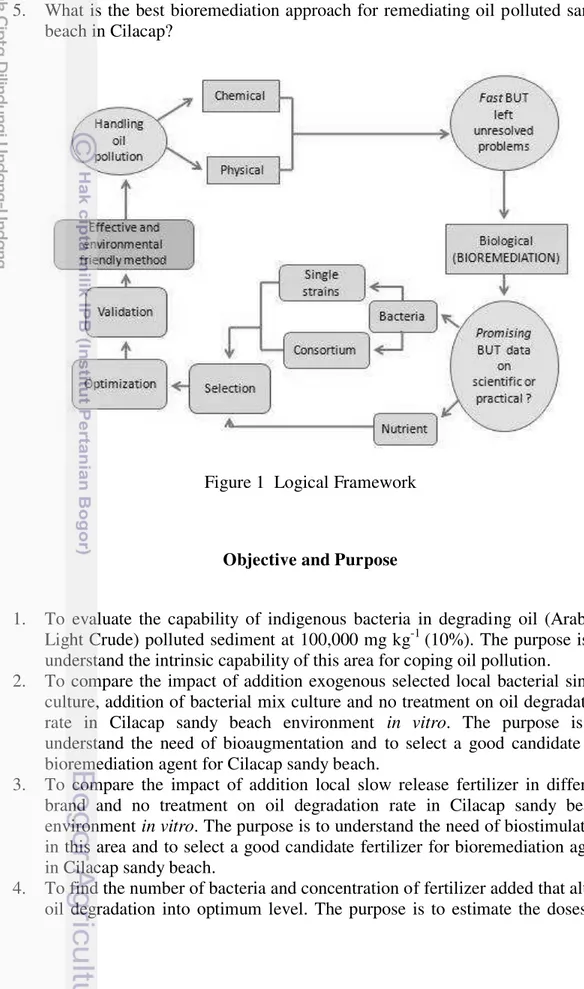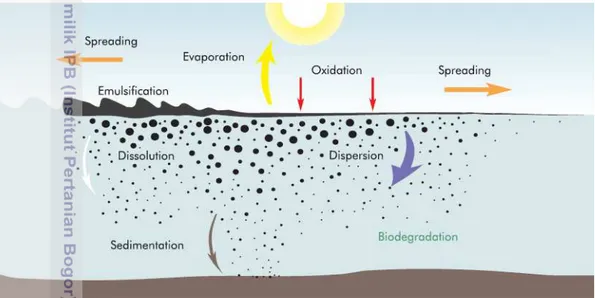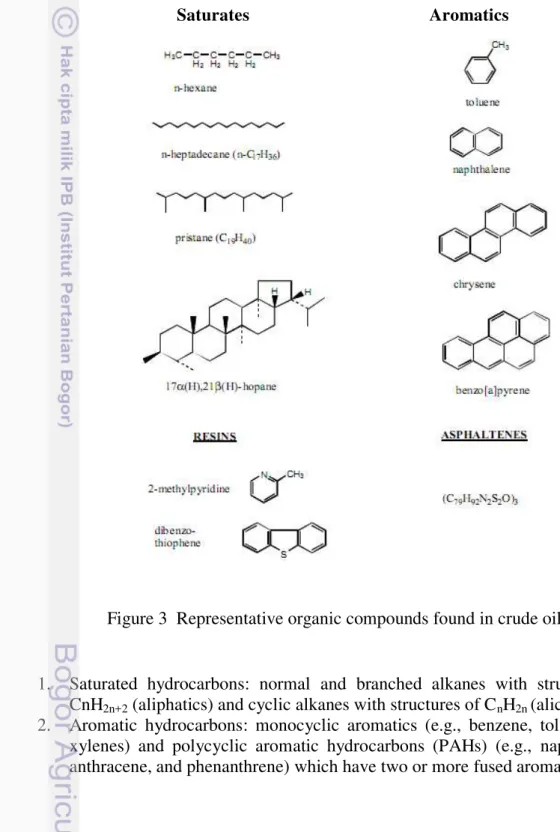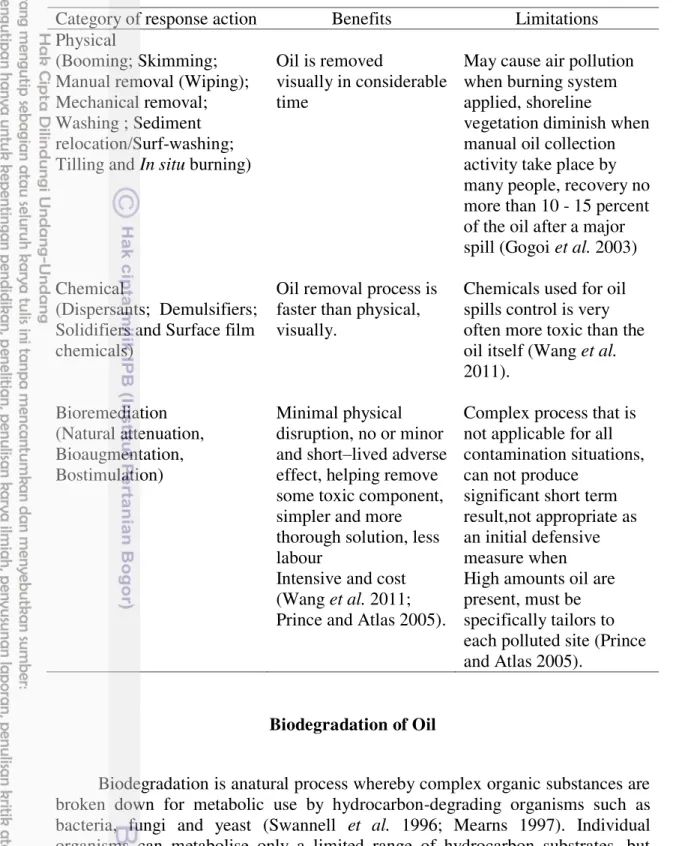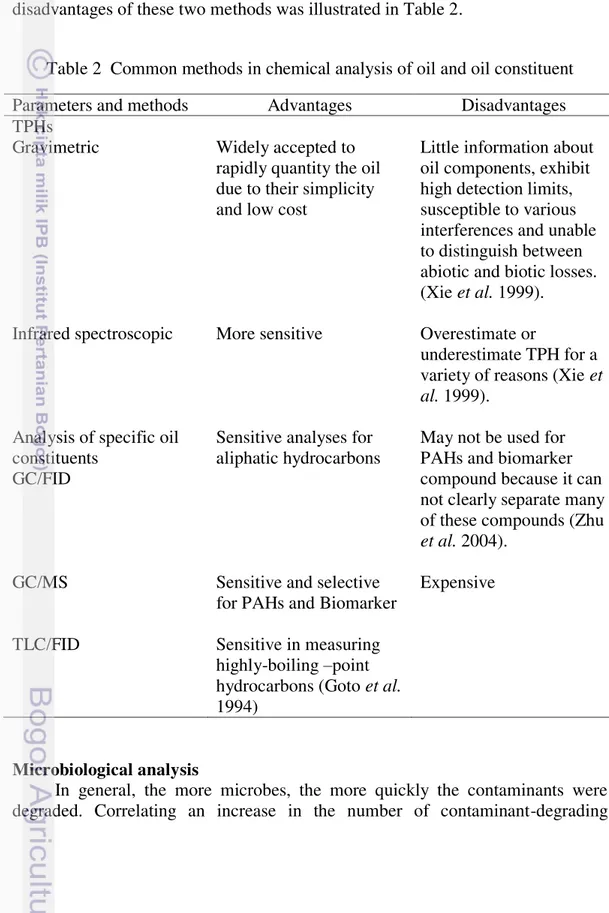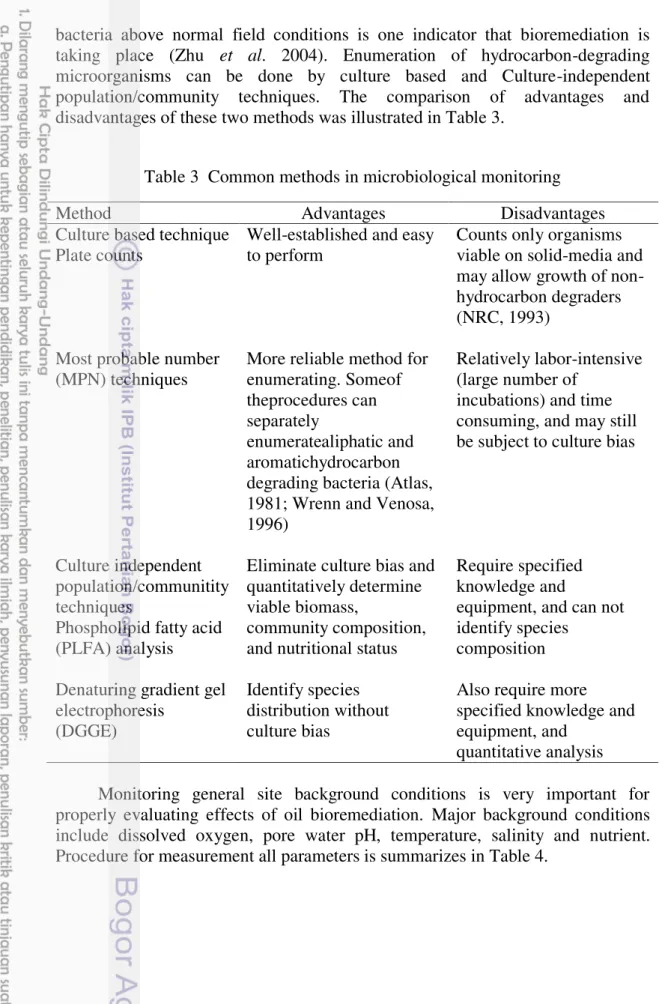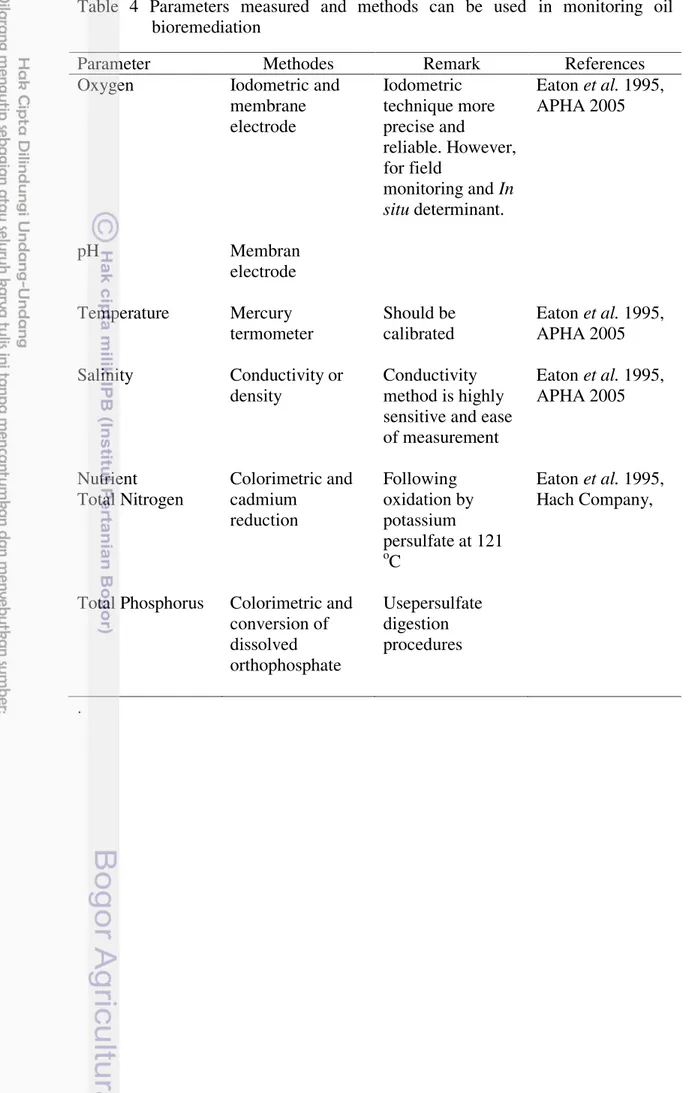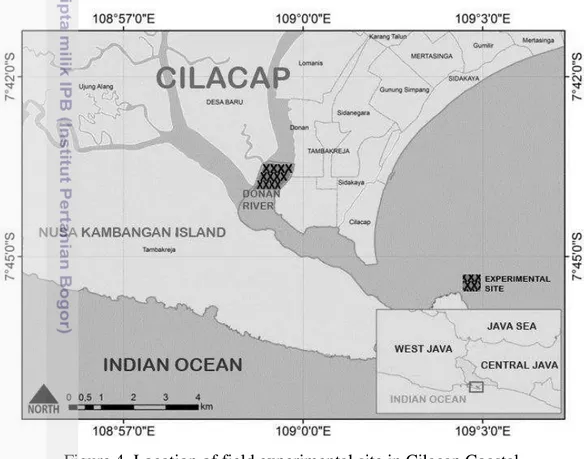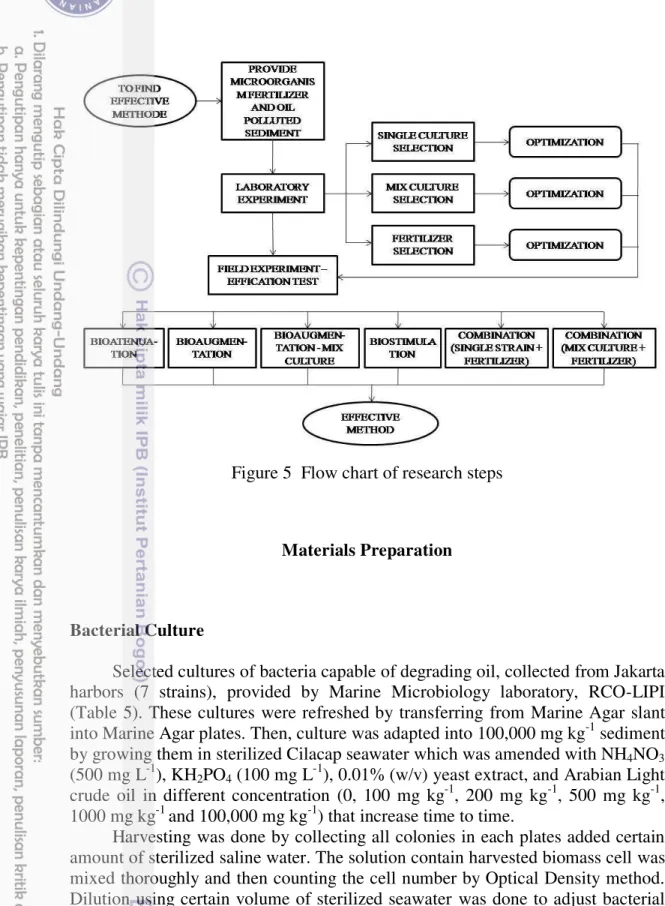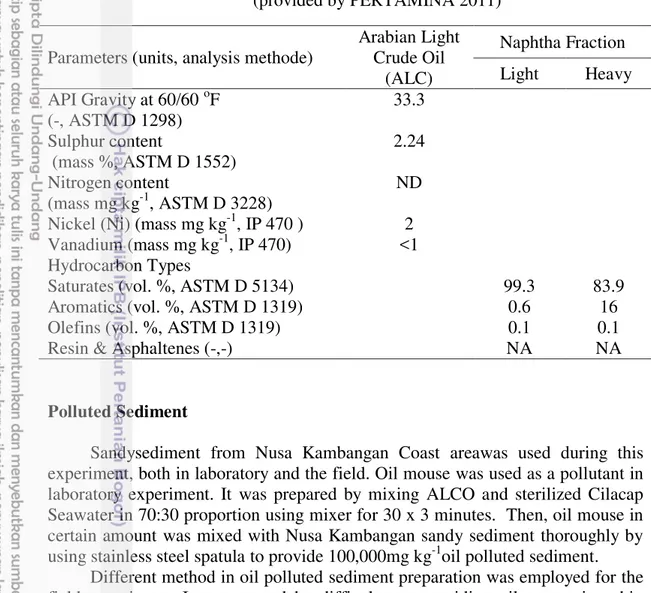JAVA, INDONESIA
YETI DARMAYATI
POST GRADUATE SCHOOL
BOGOR AGRICULTURAL UNIVERSITY
BOGOR
I hereby certify that the dissertation entitled Efficacy of Bioremediation Methods for Oil Contaminated Sandy Beach in Cilacap, Central Java, Indonesia is true of my work with the direction of the supervising commission and has not been submitted in any form to any college. The source of information originating or taken from works published or unpublished from other authors have been mentioned in the text and listed in the Bibliography at the end of this dissertation. I hereby assign copyright of my paper to the Bogor Agricultural Institute.
Bogor, January 2016
YETI DARMAYATI. Efficacy of Bioremediation Methods for Oil Contaminated Sandy Beach in Cilacap, Central Java, Indonesia. Supervised by HARPASIS S. SANUSI, TRI PRARTONO, DWI ANDREAS SANTOSA and RUYITNO NUCHSIN.
Oil spills threat Indonesian marine waters. It caused by this waters has a role as one of oil world transportation main routes and many activities of oil refineries and exploration are located in near and off shore. The most impacted area is coastal area with many problems in ecological and economical aspects emerged. The chemical and physical approaches which are not environmentally friendly have been functioned practice in addressing the problem of oil pollution in the coastal areas of Indonesia. Bioremediation is a method that use biodegradation processes to eliminate environmental pollutants. This method is very promising for the application of reducing the impact of oil spill in marine waters of Indonesia, due to the high diversity of bacteria and tropical environmental condition. However, this technique almost has never been applied in Indonesia coastal water due to it still to be developed. The reasons are limiting of understanding regarding with microbial characteristic, microbial selection, metabolism capability, interaction between indigenous and exogenous microbes, trigger needed etc. Therefore, this study was conducted to provide data and information needed to develop a common understanding of bioremediation in the oil contaminated Indonesian coastal environments.
The aim of this study was to obtain the appropriate and effective bioremediation method in controlling oil pollution in sandy beach area by conducting the laboratory and field experiments. Oil spills in Cilacap coastal area is very often occurred, therefore this area was selected as study area as a representative of chronic oil contaminated area. Using the indigenous bacteria of Indonesian waters (7 selected bacterial cultures isolated from Jakarta harbor) and local slow release fertilizer (3 different brands produced by Indonesian company) will reduce our dependency on imported products. The study consisted of several steps such as: the selection of potential bacteria and slow-release fertilizer, optimization of fertilizer concentration and density of bacteria for the best results in degrading oil, and the efficacy of various methods of bioremediation for sandy beaches.
bioaugmentation up to 6.4 and 7.5 times higher than the control experiment, respectively. Therefore, we proposed the bioremediation of oil polluted sandy beach in Cilacap would be optimal by conducting a combination between slow release fertilizer Gra at ratio concentration C/N = 1000:75 and single cultured of RCO/B/08-008 with the density of 0.5 x 108 cells mL-1.
The study of suitable biological remediation methods for anticipating oil spills in Cilacap sandy beach was conducted by using mesocosm in the intertidal area near shore of Cilacap. The result showed that after 3 months experiment, the percentage of oil depletion in control, single cultured and mix cultured treatments were 60.4 %, 74.5% and 73.5% respectively. Bioaugmentation could increase oil biodegradation in tropical sandy beach. However, bioremediation efficacy on the amendment of single cultured and mixed cultured bacteria was not significantly different.
Evaluation of using biostimulation and a combination between biostimulation and bioaugmentation by using mesocosm showed that the oil depletion rate of biostimulation-bioaugmentation combination treatment was faster and higher than biostimulation only. At the 16th day treatment, the biostimulation treated by adding the consortium and single strain increased oil depletion of 2.2 and 1.6 times higher than the control respectively. For a longer period of treatment, both the combination treatments showed a similar efficacy in degrading oil contamination. Therefore, combination of biostimulation-bioaugmentation with the consortium was proposed for combating oil-pollution for a short period.
This study concluded that bioremediation through bioaugmentation, biostimulation or the combination of both techniques could alter the oil degradation. Combination of bioaugmentation and biostimulation showed the highest oil depletion rate. The indigenous microbial agent and t h e locally product fertilizer had potency to be used in combating oil spilled. The single cultured of RCO/B/08-008 or mix cultured of RCO/B/08-008, RCO/B/08-004 and RCO/B/08-015 could be proposed as potential bioremediation agents, as well as Gra slow release fertilizer as a stimulant. Introduced single or mix cultured bacteria for oil-chronic polluted area did not cause different effect in increasing oil degradation rate. C:N ratio should be considered carefully before adding the fertilizer in oil spilled area. In Cilacap coastal area, adding the fertilizer Gra at C/N ratio of 1000:75 and intoduction of bioremediation agent at density of 0.5 x 108 cell mL-1 was appropriate to increase oil depletion rate.
YETI DARMAYATI. Efikasi berbagai Metode Bioremediasi untuk Pantai Terkontaminasi Minyak di Cilacap, Jawa Tengah, Indonesia. Dibimbing oleh HARPASIS S. SANUSI, TRI PRARTONO, DWI ANDREAS SANTOSA and RUYITNO NUCHSIN.
Perairan pesisir Indonesia sangat rentan terkena tumpahan minyak karena merupakan salah satu jalur utama minyak dunia dan memiliki banyak fasilitas pengeboran/ pengilangan minyak yang tersebar di pesisir ataupun lepas pantainya. Dalam mengatasi tumpahan minyak di perairan laut dan pesisir, Indonesia masih mengandalkan pendekatan fisik dan kimia yang kurang ramah lingkungan Pendekatan biologis (Bioremediasi), lebih ramah lingkungan dan lebih murah. Teknik ini sangat menjanjikan diterapkan karena iklim Indonesia yang tropis dan keragaman mikroba yang cukup tinggi. Namun demikian, metode ini hampir tidak pernah diterapkan di perairan pesisir karena masih belum siap. Hal ini disebabkan pemahaman yang masih sangat terbatas terkait pemilihan/penentuan mikroba, karakter/sifat mikroba, interaksi antara mikroba eksogenous dan indigenous, faktor pemacu yang dibutuhkan, dan lain-lain. Oleh karenanya studi ini dilakukan untuk mengisi kekurangan data dan informasi tersebut dia atas yang diharapkan dapat meningkatkan pemahahaman umum tentang bioremediaasi di lingkungan pesisir yang terkontaminasi minyak.
Studi ini difokuskan untuk menentukan metode bioremediasi yang tepat dan efektif untuk menangani tumpahan minyak di perairan pesisir pantai berpasir dengan menggabungkan eksperimen laboratorium dan lapangan. Tumpahan minyak di perairan pesisir Cilacap sering kali terjadi, oleh karenanya perairan ini dipilih untuk mewakili pesisir yang tercemar minyak secara kronis. Penggunaan bakteri asal perairan Indonesia (7 isolat terpilih dari pelabuhan di Teluk Jakarta) dan pupuk produk lokal (3 pupuk terpilih produksi dalam negeri) dipilih untuk mengurangi ketergantungan kita terhadap barang impor. Ada beberapa langkah penelitian yang telah dilakukan mencakup: seleksi bakteri potensial dan pupuk lepas lambat, pemilihan strategi aplikasi, optimalisasi konsentrasi pupuk dan kepadatan bakteri untuk hasil terbaik dalam mendegradasi minyak, juga efektivitas berbagai metode bioremediasi untuk lingkungan pantai berpasir.
masing-masing sampai 6.4 dan 7.5 kali lebih tinggi dari kontrolnya. Oleh karena itu, dapat diusulkan untuk bioremediasi pantai berpasir tercemar minyak di Cilacap akan optimal dengan pemberian perlakuan kombinasi penambahan pupuk lepas lambat dan bakteri. Kombinasi tersebut adalah penambahan pupuk lepas lambat pada konsentrasi dengan perbandingan C:N = 1000:7.5 dan kultur tunggal bakteri RCO/B/8-008 (homologi dengan Alcanivorax sp. TE-9 100%).
Untuk mengetahui pendekatan remediasi yang tepat dalam menanggulangi minyak di pantai berpasir Cilacap, evaluasi efikasi metode bioremediasi di lapangan telah dilakukan dengan pendekatan mesokosme di daerah pasang surut Cilacap. Hasil penelitian menunjukkan bahwa penurunan konsentrasi minyak mencapai 60.4 %, 74.5% dan 73.5 % dalam kurun waktu 3 bulan, masing-masing pada kontrol, perlakuan kultur tunggal dan kultur campuran. Biaugmentasi dapat meningkatkan laju biodegradasi di pantai berpasir tropis. Namun perbedaan efikasi dari penambahan kultur tunggal dan kultur campuran secara statistik tidak nyata
Evaluasi biostimulasi dan kombinasi biostimulasi-bioaugmentasi telah menunjukkan bahwa efektivitas penurunan konsentrasi minyak pada perlakuan kombinasi biostimulasi-bioaugmentasi lebih cepat teramati dan lebih tinggi daripada perlakuan biostimulasi saja. Pada hari ke-16 setelah aplikasi pupuk yang ditambah kultur campuran dan kultur murni persentasi penurunan minyaknya masing -masing mencapai 2.2 dan 1.6 kali lebih tinggi daripada kontrol Namun untuk periode yang lebih panjang, kedua perlaku an kombinasi ini memiliki efikasi yang relatif sama. Untuk itu, penggunaan kombinasi biostimulasi dengan kultur campuran lebih disarankan untuk menangani pencemaran dalam periode yang pendek .
Kesimpulan dari kajian ini adalah tumpahan minyak di lingkungan pesisir- tercemar minyak yang kronis, dapat terdegradasi secara alami tetapi dalam tingkat yang rendah. Bioremediasi baik melalui bioaugmentation, biostimulation maupun kombinasi keduanya terbukti secara signifikan mampu meningkatkan laju degradasi minyak. Kombinasi bioaugmentation dan bistimulation menunjukkan tingkat penurunan konsentrasi minyak paling tinggi. Hal itu terbukti dalam percobaan in vitro dan mesocosm. Ada agen mikroba indigenous dan pupuk produk lokal yang prospektif untuk digunakan dalam menanggulangi tumpah minyak. RCO/B/08-008 dalam bentuk kultur tunggal atau dalam kultur campuran dengan RCO/B/ 08-004 dan RCO/B/ 08-015 dapat diusulkan sebagai agen bioremediasi, serta pupuk lepas lambat Gra sebagai agen stimulan potensial. Pemberian kultur tunggal atau campuran untuk daerah tercemar minyak kronis tidak menimbulkan efek yang berbeda dalam meningkatkan laju degradasi minyaknya. Perbandingan nilai C:N rasio harus dipertimbangkan dengan hati-hati sebelum menambahkan pupuk di wilayah tercemar minyak. Untuk pesisir Cilacap, penambahan pupuk G pada konsentrasi N dengan perbandingan C:N = 1000:75 dan kultur bakteri dengan kepadatan 0.5 x 108 sel mL-1 cukup untuk meningkatkan laju degradasi minyak.
© All Rights Reserved IPB, the Year 2016
Copyright Reserved
Quote some or all of this paper without including or mentioning the source. Quoting is only for educational purposes, research, scientific thesis, report writing, criticism, or review an issue; and citations are not detrimental to the interests of IPB.
JAVA, INDONESIA
YETI DARMAYATI
A dissertation
submitted in partial fulfillment of the requierements for the degree of Doctoral
in Marine Science Major
POST GRADUATE SCHOOL
BOGOR AGRICULTURAL UNIVERSITY
BOGOR
Penguji pada Ujian Tertutup : Prof Dr Ir Dietriech Geoffrey Bengen DEA Dr Ir Agung Dhamar Syakti DEA
NIM : C561100022
Approved by
Graduate Committee
Prof Dr Ir Harpasis S. Sanusi, MSc. Chairman
Dr Ir Tri Prartono, MSc. Member
Prof Dr Ir Dwi Andreas Santosa, MSc. Member
Prof Drs Ruyitno Nuchsin, MSc. Member
Acknowledged by
Head of Marine Sciences Major
Dr Ir Neviaty P. Zamani, M.Sc.
Dean of Graduate School
Dr Ir Dahrul Syah, M.Sc.Agr.
blessings and gifts so that this dissertation was completed. The dissertation
entitled Efficacy of Bioremediation Methods for Oil Contaminated Sandy
Beach in Cilacap, Central Java, Indonesia, is conducted to develop an effective clean-up method for reducing the impact of oil spills in tropical marine environment.
I am immensely grateful to those individuals who have helped to complete my doctoral study in Bogor Agricultural University. As the outset, I would like to express my great appreciation to Prof Dr Ir Harpasis S. Sanusi MSc, for his
enthusiastic support, guidance, being always there, and the time spent in guiding
me through the writing process. As my supervisor, his observation and comments helped me to establish the overall direction of the research and to
move forward with its investigation in depth. I would like also to express my
gratitude to my supervisors Prof Drs Ruyitno Nuchsin MSc, Dr Ir Tri Prartono MSc, and Prof Dr Ir Dwi Andreas Santosa MSc for their help, support and guidance both during the study and in the writing of a dissertation
I acknowledge Prof Dr Ir Dietriech Geoffrey Bengen DEA, Dr Ir Agung Dhamar Syakti DEA, and Dr Ir Zainal Arifin MSc as external examiner commission has been testing, analyzing and providing input for the perfection of
this dissertation. Many thank to Dr Ir Neviaty P. Zamani MSc as the Chairman
of Marine Science study program who has directed and encouraged me for implementing education in Marine Science Program SPs IPB. I will not forget Dr
Dirhamsyah MA, and Dr Suhartati M. Natsir for their great help and granted
permission during my doctoral program.
I would like to express my thanks to Ministry of Research and
Technology and Indonesian Institut of Sciences which has provided me scholarships for Doctoral Program in IPB and financial support for the implementation of this research, respectively. Also, to PERTAMINA Refinery Unit IV Cilacap and BPLHD Cilacap for their cooperation to conduct this Tumpak Sidabutar, Ani, Denti, Dr Nurul Dhewani, Femi Hukom, for your help, support and togetherness. I appreciate Surahman, Bella S. Rosepta, Wahyu Utomo, Tia D. Martianingsih, Dwi Astuti, Linda Safitri and all member of bioremediation research group Research Center for Oceanography – LIPI for their technical assistance in this research.
Bogor, January 2016
TABLE OF CONTENT
LIST OF TABLE xii
LIST OF FIGURE xiii
1 GENERAL INTRODUCTION 1
Background 1
Logical Framework 2
Objective and Purpose 4
Goal 5
Novelty 5
2 LITERATURE REVIEW 6
Oil Pollution in Marine Environments 6
Biodegradation of Oil 10
Bioremediation in Oil Polluted Shoreline 17
3 GENERAL METHODOLOGY 26
Time and Study Site 26
Reseach Steps 27
Materials Preparation 28
Laboratory Experiment 31
Field Experiment 33
Sample Analysis 36
Data Analysis 37
4 POTENTIAL MICROBIAL AGENT FOR CRUDE OIL
DEGRADATION 38
Introduction 38
Materials and Methods 39
Result and Discussion 42
Conclusion 45
5 ALTERNATIVE SLOW RELEASE FERTILIZER ENHANCES BIODEGRADATION OF OIL CONTAMINATED TROPICAL
SANDY BEACHES 47
Introduction 47
Materials and Methods 48
Result and Discussion 50
Conclusion 55
6 OPTIMAL BACTERIAL DENSITY AND FERTILIZER CONCENTRATION FOR BIOREMEDIATION OF OIL
CONTAMINATED SANDY BEACH 56
Introduction 56
Materials and Methods 57
Results and Discussion. 59
7 THE EFFICACY OF BIOAUGMENTATION ON REMEDIATING OIL CONTAMINATED SANDY BEACH USING MESOCOSM
APPROACH.1 66
Introduction 66
Materials and Methods 66
Results and Discussion 70
Conclusion 75
8 THE EFFECT OF BIOSTIMULATION AND BIOSTIMULATION-BIOAUGMENTATION ON BIODEGRADATION OF
OIL-POLLUTION ON SANDY BEACHES USING MESOCOSMS 76
Introduction 76
Materials and Methods 77
Results and Discussion 81
Conclusion 89
GENERAL DISCUSSION 900
CONCLUSION 92
REFERENCES 93
CURRICULUM VITAE 104
LIST OF TABLE
1 Shoreline clean-up options, benefits and limitations 10 2 Common methods in chemical analysis of oil and oil constituent 23 3 Common methods in microbiological monitoring 24 4 Parameters measured and methods can be used in monitoring oil
bioremediation 25
5 Selected cultured used for the experiment 29
6 Physicochemical characteristics of Arabian Light Crudeoil used
(provided by PERTAMINA 2011) 30
7 Composition of slow release fertilizer content 31 8 Treatments for bacterial and fertilizer selection experiments 31 9 Treatment for optimization bacteria and fertilizer experiment 32
10 Treatment employed in field experiment 35
11 Measurement of physicochemical parameters 37
12 The composition of bacterial mixed culture 39
13 Environmental parameters condition over 28 days experiment 52 14 Soluble Total Nitrogen and Phosphate during experiment 54 15 Treatments performed for optimalization study 58 16 Environmental parameters in the range during 28 days experiment 65 17 Pore water quality in average and range value during 90 day
sexperiment 70
18 First order rate constant (k) value in different treatment at various
19 k value in each treatments at different time periods 82 20 Pore water quality over time experiment inside and outside mesocosm 84
LIST OF FIGURE
1 Logical Framework 4
2 Major weathering processes after an oil spills (ITOPF 2009) 6 3 Representative organic compounds found in crude oil 7 4 Locationof field experimental site in Cilacap Coastal 26
5 Flow chart of research steps 28
6 Bioreactor 29
7 Experiment in microcosm system 32
8 Plot lay out on the inter-tidal foreshore of Cilacap Coastal 34
9 Schematic design of mesocosm 34
10 Porewater sampler and capiler hose forsucking the sample 35
11 Research design for bacteria selection 40
12 Residual oil content in single (A) and mix culture (B) treatment 43 13 Bacterial growth of single (A) and mix culture (B) 45 14 Oil depletion percentage in different fertilizer treatment during 28 days
experiment 50
15 Bacterial growth in 4 different SRF treatments over 28 days experiment. Standard deviations of the replicates (n = 3) are denoted by the error bars. Columns marked by the same letter (a to d) are not
significantly different (p<0.05). 51
16 The impact of N addition at various concentration on oil depletion rate and bacterial growth. Standard deviations of the replicates (n = 3) are denoted by the error bars. Columns marked by the same letter (a to d)
are not significantly different (p<0.05). 60
17 The impact of bacterial amendment on oil depletion rate and bacterial growth. Control = no bacterial addition. Single culture and mix culture was amended in two different densities which were 1.0 x 108 cells mL-1 (1) and 0.5 x 108 cells mL-1 (0.5). Columns marked by the same letter (a to d) are not significantly different (p<0.05). 61 18 Comparison of oil degradation rate and bacterial growth in artificial oil
polluted sediment exposed by different treatment of N concentration and bacterial amendment for 28 days experiment. Standard deviations of the replicates (n=3) are denoted by the error bars. Columns marked by the same letter (a to d) are not significantly different (p<0.05). 63 19 Bacterial growth during 90 days experiment, standard deviation of the
replicates (n-3) are denoted by the error bar 72
20 Oil degradation percentage during 90 days experiment, standard deviation of the replicates (n-3) are denoted by the error bar. Colums marked by the same letter (a to c) are not significantly different (p<0.5) 74 21 Plot lay out on the inter-tidal foreshore of Donan River bank on a
22 Schematic of Mesocosm (A) and Mesocosms in the location site at high
tide (B) `80
23 Oil depletion percentage over time for the mean of each treatment. Deviations of the replicates (n=3) are denoted by the error bars. Colums marked by the same letter (a to c) are not significantly different (p<0.5) 82 24 Relation of oil depletion (%) and bacterial cell numbers in eacht
reatments duringthe 90 daymesocosm experiment. 83 25 Pore water quality in each treatments over time mesocosm experiment.
1
GENERAL INTRODUCTION
Background
Indonesian marine waters has highly risk on oil spill disaster.It is due to a number of offshore explorations, coastal oil refineries and a main route for oil world transportation. In addition, oil spillage from domestic waste introduced to the sea via river runoff is also may not be ignored (Darmayati 2009a). Concerning with these activities, there were 100,000 vessel and 32,836 tanker (capacity: 500,000 – 5,000,000 ton) passing through Malaka Straits in 1993. Of course the number has been doubled or higher up till now. There are also over 2000 kilometres of submersible pipes lines and hoses, over 150 oil jetties, 6 major processing plants and 4 major big Transit Terminals all over Indonesia. Oil spill accidents have been recorded at least 30 times in all over Indonesian marine waters during 1975 – 2008. As an example, ITOPF (2009) mentioned that several spills have threatened the Sumatran Coast, including the SHOWAMARU (1975; 4,000 tonnes), NAGASAKI SPIRIT (1992; 13,000 tonnes) and MAERSK NAVIGATOR (1993; 25,000 tonnes). Several tanker accidents have been recorded such as SUPPLY NO 27 in Tanjung Priok (1998), STEADFAST in Tegal (2001) and MT KHARISMA SELATAN in Surabaya (Sudrajad 2006). Cilacap coastal area is one of the areas that the most often spilled by oil in Indonesia. Based on data from various sources, during the period 2000-2015, at least there were 10 cases of oil spills occurred in Cilacap area, 7 cases were due to tanker accidents and 3 cases due to the leaked pipe or damaged facilites (Wagino 2011; Pristiyanto 2012; Mauludiyah 2012).
Oil pollutants pose a serious and wide range threat to fishery, marine habitats of wildlife, human health, and destroy the ecological balance which may take years or even decades to recover (Zhang et al. 2011). These environmental risks are due to the organic compounds mixed with different characteristic and properties of oil, e.g. polycyclic aromatic hydrocarbons (PAHs). PAHs compounds are toxic, persistent, bioaccumulative, mutagenic and carcinogenic for biota and human being (Zakaria et al. 2009). Therefore, it is very urgent to develop an effective clean-up method for reducing the impact of oil spills on marine life.
Physical and chemical approaches have been already established and common employed in handling oil spills in Indonesia. Visually the oil can be removed fastly.but the remaining oil will become the unresolved problems. These were include air pollution when burning system used, diminished shoreline vegetation when many people collected oil manually, recovery no more than 10-15 % of the oil after a major spill, and chemicals used for oil spills control is very often more toxic than the oil itself (Gogoi et al. 2003).
degradation processes depends on several factor such as environmental conditions (pH, temperature, oxygen, degree of acclimation, accessibility of nutrient), number of microorganism, type of microorganism, cellular transport properties, chemical partitioning in growth medium, and chemical structure of compounds degraded (Coartes et al. 2009; Lin et al. 2009). Bioremediation is a technology which still considered as an innovative technique by the U.S. Environmental Protection Agency (EPA). It has been the diffficulty in establishing engineering parameters that ensure the reliability. However, with greater understanding of microbial biodiversity and development of bioengineering, bioremediation is taking place as one of the best, effective and economist solution in integrated environmental restoration effort (Philp et al. 2005).
The high biodiversity in Indonesian marine environment is actually the source of diverse marine microbes that potentially can degrade oil. It means, oil pollution problem in Indonesia can be solved by the using the certain marine microbes. However, study of using marine microbes for this purpose is still very limited in scientifically or practically (Darmayati 2009a; Munawar et al. 2007; Syakti et al. 2008). Therefore, many questions are still needed to be answered to maximize the inherent potency of indigenous marine microbes in degradation of oil spills. Study of the efficacy of bioremediation methods for oil polluted coastal area in Cilacap can be used as a model to provide information and effective bioremediation technique which suitable for Indonesian coastal area.
A series experiment was conducted in the laboratory and the field by using microcosm and mesocosm approaches, respectifully. Microcosm approach was used to select and optimize the bacteria and employing the nutrient for bioremediation process. In this step, oil degrading bacteria collected from Jakarta Bay and slow release fertilizer of Indonesian product was used to provide the best candidate for using the validation experiment. Validation experiment is the main study conducted using mesocosm approach to get better understanding of the result for field application. Mesocosms is an experimental technique which bridging laboratory and field experiments. Validation experiment was conducted to confirm the efficacy of 5 different bioremediation techniques in combating oil pollution in Cilacap sandy beach. The result can be used as a guidance to decide an appropriate and effective bioremediation method when Cilacap coastal area polluted by crude oil. Moreover, it may also beused as a solution model for combating oil pollution in other Indonesian coastal waters.
Logical Framework
this area, bioremediation technique can be proposed. The reason is oil is an organic compound that can be degraded by bacteria. Oil degrading bacteria is available in this environment. Tropical condition will support biodegradation process in this coastal.
In general, bioremediation application fall into two broad categories are known as in situ and ex situ bioremediation (US EPA 1999). In situ bioremediation treats contaminated soil in the location in which it was found and less costly. Bioatenuation, bioaugmentation, and biostimulation are technologies common approaches used for clean up oil contaminated marine ecosystem (Prince and Atlas 2005).
Some biostimulation studies conducted have proved that growth of oil-degrading bacteria and oil degradation can be strongly enhanced by fertilization with inorganic N and P (Röling et al. 2002). In situ test in Surabaya coastal indicated that organic nutrient (Petroganik©) stimulatesoil microorganism in oil polluted environment (Munawar et al. 2007). Previous study in laboratory and mesocosms also showed that Osmocote©, one of slow-release fertilizer (USA product) widely used in coastal oil bioremediation studies can enhanced oil degradation in Seribu Island (Darmayati 2010). To develop bioremediation technique for Cilacap area, selection on alternative fertilizer from local product on purpose of enhancing oil degradation in low cost was conducted.
Bioaugmentation has been considered as a potential strategy for oil bioremediation since the 1970s, although hydrocarbon-degrading microorganisms are widespread in nature (Zhu et al 2001). Many commercial bioaugmentation products are the result of a large-scale fermentation of single or mix culture (Forsyth et al. 1995).The efficacy of microorganism addition to oil polluted environment is still debatable. Some of them have shown the capability to degrade petroleum in the lab and under controlled conditions (Raghaven and Vivekanandan 1999), the other study showed no significant result on enhancing biodegradation rate (Simon et al. 2004). Selected oil degrading bacteria from Jakarta Bay has been exhibited an enhancement of oil degradation in laboratory (Darmayati 2009b; Hatmanti et al. 2009). However, the efficacy of this fertilizer (biostimulation) and bacterial application (bioaugmentation) in the field was still questionable for Indonesian marine waters.
Until now, almost no implementation of bioremediation techniques at oil polluted sites on the coastal of Indonesia. Therefore many aspects still have to be studied to develop general understanding on bioremediation for Indonesian coastal. Study on the efficacy of bioremediation methods for oil polluted coastal urgently needed. The aim of this research into obtain bioremediation method appropriate and effective for controllingoil spilled in Cilacap by combining laboratory and field experiments. As a summary, logical framework of this research is presented in flowchart below (Figure 1). This study was conducted to answer these questions below:
1. How does the response of indigenous bacteria in coastal sediment to cope oil pollution at 100,000 mg kg-1 occur in this area?
3. What is the impact of nutrient addition on enhancing oil degradation in Cilacap sandy beach and which is the best fertilizer for this matter?
4. How much bacteria and fertilizer should be added to provide the highest rate of oil degradation?
5. What is the best bioremediation approach for remediating oil polluted sandy beach in Cilacap?
Figure 1 Logical Framework
Objective and Purpose
1. To evaluate the capability of indigenous bacteria in degrading oil (Arabian Light Crude) polluted sediment at 100,000 mg kg-1 (10%). The purpose is to understand the intrinsic capability of this area for coping oil pollution.
2. To compare the impact of addition exogenous selected local bacterial single culture, addition of bacterial mix culture and no treatment on oil degradation rate in Cilacap sandy beach environment in vitro. The purpose is to understand the need of bioaugmentation and to select a good candidate for bioremediation agent for Cilacap sandy beach.
3. To compare the impact of addition local slow release fertilizer in different brand and no treatment on oil degradation rate in Cilacap sandy beach environment in vitro. The purpose is to understand the need of biostimulation in this area and to select a good candidate fertilizer for bioremediation agent in Cilacap sandy beach.
bacteria and fertilizer to be applied in environment for gaining an optimum result.
5. To evaluate the efficacy of certain strategy for bioremediation oil polluted Cilacap sandy beach in the field. The purpose is to establish the best bioremediation method for Cilacap sandy beach in cleaning up oil pollution.
Goal
The goal of this study is to develop efficient and environment friendly method for clean up oil pollution in Cilacap sandy beach using local natural resources. The technique can be proposed to anticipate any remediation effort for recovering oil polluted sandy beach environment in Cilacap coastal. This knowledge may help also as a considerant for other bioremediation effort of sandy beach environment in Indonesia. Therefore, guidelines in application of bioremediation for oil polluted sediment in Indonesian coastal can be developed. In addition, if this local selected oil degrading bacteria and local fertilizer tested are proven successfully enhance oil biodegradation; it might be also developed as bioremediation agent for tropical coastal sediment.
Novelty
New findings of this study areas followed:
1. Indigenous microbial agent which include RCO/B/08-008 isolate (homology 100% with Alcanivorax sp. TE-9), RCO/B/08-013 (homology 98% with P. balearica) and RCO/B/08-015 can be proposed as potential bioremediation agents
2. Addition of fertilizer C at C/N ratio of 1000:75 and introduction of bioremediation agent at density of 0.5 x 108cells mL-1 is appropriate to increase oil degradation rate.
2
LITERATURE REVIEW
Oil Pollution in Marine Environments Source and Behaviourof Oil
Oil and oil products are the most widespread contaminant in the world. There are three potential sources from which these compounds can enter the marine environment. The greatest contributor is continuous low-level input (e.g. from road surfaces, domestic waste and lowlevelseepage from oil underground storage tanks). Major spillages from tankers, pipelines and storage tanks are a relatively minor contributor to overall pollution levels. The final source is from slow natural seepage from oil reservoirs (Morgan and Watkinson 1989).
Figure 2 Major weathering processes after an oil spills (ITOPF 2009)
Physico-Chemical Characteristics of Oil
Crude oil and petroleum productsexhibit a wide range of physical properties due to their content are mixtures of thousands of individual compounds which are very complex. Crude oil is comprised of both hydrocarbon compounds (50–98%) and non-hydrocarbon compounds (such as sulfur, nitrogen, oxygen, and various trace metals) in a wide array of combinations (Clark and Brown 1977). Leahy and Colwell (1990) categorized petroleum hydrocarbons based on their differential solubility in organic solvents into four classes (Figure 3) such as followed:
Saturates Aromatics
Figure 3 Representative organic compounds found in crude oil
1. Saturated hydrocarbons: normal and branched alkanes with structures of CnH2n+2 (aliphatics) and cyclic alkanes with structures of CnH2n (alicyclics).
3. Resins: polar compounds containing nitrogen, sulfur, and oxygen (e.g., pyridines and thiophenes).
4. Asphaltenes: poorly characterized high molecular weight compounds that include both high molecular weight and poorly characterized hydrocarbons and NSOs.
The main physical properties which affect the behaviour and the persistence of an oil spilled at sea are specific gravity, distillation characteristics, viscosity and pour point. All are dependent on chemical composition (e.g. the amount of asphaltenes, resins and waxes which the oil contains) (ITOPF 2002).
Oil Spills in Marine Environment
Oil pollution in marine environment is not only problem for the world but also for Indonesia. Marine life is still threatened by oil and oil product pollution, althoughthe number of tankers collision has decreased in number nowadays. Spills from operational discharge, pipeline ruptures and leakages have increased.Besides, oil exploration and extraction is moving into ever deeper and into stormier and icier seas, increasing potential risk (Jernelov 2010). Australian Montara Well Head Platform drilling installation in the West Atlas Block, caught fire on August 2009 is as an example (Gunanto and Seo 2010).
Until now, Indonesian crude oil production continued to decline to an unofficial 1.06 million b/d, falling short of its 1.08 million b/d target (Embassy of the United Stated of America, 2006). However, the quantity of pollutants from oil and gas exploration and exploitation activities were continuously being discharged into Indonesian marine waters. It may caused by the growing of industrialization and demand for energy resources has led to a considerable increase in marine transportation of crude oil and offshore exploration activities.Besides, continuous input from land activities is also high.
Indonesia has very complicated oil supply and distribution system that have high risk on polluting their marine waters. Satya (2007) mentioned that Indonesia has 5 STS (Ship to Ship transfer) and 10 Single Buoy Mooring (SBM). Large tankers come to these STS unloading oil products, then it will be tranferred to medium or small tankers. These tankers will go passing through out Indonesia water to all oil depots or oil terminals. Large tankers discharge oil products to these SBM and then oil products go to oil depots or oil terminals by submersible hoses or pipe with the length of over 5000 kilometres. There are more than 82 explorations activities operating onshore and offshore, over 150 oil jetties, 6 major processing plants and 4 major big Transit Terminals.
Environmental Concerns about Oil and PAHs
Oil spills can harm marine life in three different ways, by poisoning after ingestion, by direct contact and by destroying habitats (IMO, 1993). Therefore, impact of oil spills on marine ecosystem, particularly large scale spill accidents, have posed great threats and cause extensive damage to the marine coastal environment. It can be concluded that the range of oil impacts after a spill are physical and chemical alteration of natural habitats, physical smothering effect on flora and fauna, lethal and sub-lethal toxic effect on flora and fauna, short and longer term changes in biological communities resulting from oil effects on key organisms, tainting of edible species, loss of use of amenity, loss of market for fisheries products and tourism, fouling of marine/coastal infrastructure, and temporary interruption of industrial processes requiring a supply of clean seawater (White and Baker 1998; Ben-David et al. 2001).
Polycyclic Aromatic Hydrocarbons (PAHs) are ubiquitous environmental pollutants with low bioavailability, high persistence in soil and potential deleterious effects on human health range in size from two to six rings (Johnsen et al. 2005). Contamination of PAHs can result from natural and anthropogenic processes, inputs of PAHs from human activities such as oil spill, offshore
production, transportation and combustion are very significant and pose serious
threats tocoastal habitats (Corredor et al. 1990). On the basis of their abundance and toxicity (carcinogenic, mutagenic and toxic properties), 16 PAH compounds have been identified by the U.S. Environmental Protection Agency (EPA) as priority pollutants, including anthracene (ANT), phenanthrene (PHE) and Dibenzothiophene (DBT) (Yang et al. 1998; Habe and Omori 2003).
Clean Up Oil Spill
Strategies for cleaning up an oil spill are greatly affected by a variety of factors, such as the type of oil, the characteristics of the spill site, and occasionally political considerations. A number of approaches and technologies have been developed for controlling oil spills in marine shorelines and freshwater environments. Common clean-up option can be categorized into three methods which are bological, physical and chemical.
Table 1 Shoreline clean-up options, benefits and limitations
Category of response action Benefits Limitations Physical
Hydrocarbons differ in their susceptibility to microbial attack whereby lighter oils degrade more quickly than heavier oils and n-alkanes degrade more rapidly than branched alkanes, whilst cycloalkanes are the most resistant to microbial attack (Atlas 1981; Wang et al. 1998). Biodegradation of oil results in a decrease in saturated and aromatic hydrocarbon content, whilst there is an increase in oil density, sulphur content, acidity and viscosity (Roling et al.2003).
Mechanisms of Petroleum Hydrocarbon Biodegradation
There are three metabolic pathways by which microbes can reduce or alter hydrocarbon constituents which are aerobic respiration; anaerobic respiration and fermentation. Amongst these pathways, aerobic respiration is the most efficient in terms of energy production and fermentation the least. This is also the case in terms of the practical application of metabolic strategies to environmental bioremediation, where the rate of aerobic metabolism is usually greatest and most effective in the destruction of petroleum hydrocarbons.
Many research studies have been conducted on hydrocarbon utilization by microorganisms. The metabolic degradation pathways of alkanes (Watkinson and Morgan 1990), cycloalkanes (Perry 1984), and aromatics (Cerniglia 1992) have been widely studied as they are the predominant constituents of crude oil and many petroleum products. Their metabolic pathways under aerobic conditions are summarized below.
Microbial degradation of alkanes
Molecular oxygen (O2) is usually required to affect biodegradation of
alkanes. It has been reported that the microbial degradation of n-alkanes normally proceeds by a mono-terminal attack resulting in the production of a primary alcohol. Subsequently, aldehyde and monocarboxylic acid are formed, as summarized below (Singer and Finnerty 1984):
Alkane →Alcohol →Aldehyde → Fatty Acid → Acetate → CO2 + H2O +
biomass
Further degradation of monocarboxylic acids proceeds via β-oxidation with the subsequent formation of a fatty acid that is two-carbon-unit-shorter and acetyl coenzyme A, with the eventual liberation of CO2 (Atlas and Bartha 1992). Highly
branched isoprenoid alkanes normally undergo ω-oxidation and form dicarboxylic acids. Pristane is a typical branched alkane that follows this degradation pathway. Methyl branching generally increases the resistance of hydrocarbons to microbial attack (Singer and Finnerty 1984; Atlas and Bartha 1992).
Microbial degradation of cyclic hydrocarbons
there is an n-alkane of adequate chain length (Perry 1984). The pathway of cycloalkane biodegradation is shown as:
Cycloalkane → Cyclic alcohol → Cyclic ketone → Cyclic lactone → CO +
biomass.
Microbial degradation of aromatic hydrocarbons
The biodegradation of aromatic compounds usually involves the action of a dioxygenase resulting in the formation of a diol that spontaneously decays to catechol. This is oxidatively cleaved to form a diacid by ortho or meta cleavage (Cerniglia, 1992). The metabolic pathway is shown as:
Aromatic → Diol → Catechol → Diacid → CO2 + H2O + biomass
Microbial degradation of resins and asphaltenes
Compared to saturates and aromatics, very little is known about biodegradation of resins and asphaltenes; this is due to their complex structures, which are difficult to analyze. Resins and asphaltenes have previously been considered to be refractory to degradation. However, there is recent evidence of asphaltene degradation through cometabolism (Leahy and Colwell 1990). Some resins, particularly low-molecular-weight resin fractions, can also be biodegraded at low concentrations (NAS 1985). Further research is still needed to understand the biodegradation of these compounds.
Factors Affecting Oil Biodegradation
Normally, the factors that affect the biodegradation of hydrocarbons can be divided into three aspects: physical, chemical and biological. A thorough understanding of these factors is necessary to undertake remedial action and to optimize the biotreatment process. Signification factors that affect biodegradation are summarized in this section, including chemical composition, physical state and concentration of oil hydrocarbons in contaminant, sediment texture and structure, oxygen availability, moisture content, nutrient availability, redox potential, temperature, pH and the presence of hydrocarbon degrading microorganisms.
Chemical composition, physical state, and concentration of oil
another important factor that influences the overall biodegradation rate of both the oil and its component fractions (Jobson et al. 1972).
In aquatic systems, the oil spreads forming a thin slick. In soil, the oil moves vertically down wards and is adsorbed on the soil particles. Evaporative loss of volatile hydrocarbons is limited in the case of oil in sediments, resulting in toxicity to microorganisms. The effective toxicity of petroleum constituents can be significantly reduced by absorption onto the solid phase. However, persistent oil residues are often formed as a result of absorption and adsorption to humic substances (Bossert and Bartha 1984).
High concentrations of hydrocarbons can be associated with heavy, undispersed oil slicks in water, causing inhibition of biodegradation by nutrient or oxygen limitation or through toxic effects exerted by volatile hydrocarbons (Fusey and Oudot, 1984). The rates of mineralization of the higher-molecular-weight aromatic hydrocarbons, such as naphthalene and phenanthrene, are related to aqueous solubilities rather than total substrate concentrations (Johnsen et al. 2005). The concept of maximum or threshold concentrations for microbial degradation of hydrocarbons may apply also to soil ecosystems.
Sediment texture and structure
Sediment texture and structure is a key factor in the application of oil bioremediation strategies. Texture affects the biodegradability of hydrocarbons and the ability of microbes to metabolize the compounds by influencing rates of aeration and water infiltration, permeability, holding, and adsorption capacity (Hornick 1983). The sediment type also determines the microbial populations present and the mobility of microbes through the contaminated subsurface (Romero 1970).
Oxygen availability
Aerobic respiration is the metabolic pathway, which is more efficient than anaerobic respiration and fermentation. Therefore, it is usually the preferred method to use in oil bioremediation. The oxidation of the substrate by oxygenases during the process of aerobic respiration, for which molecular oxygen is required, occurs in the initial steps of catabolism of aliphatic, cyclic and aromatic hydrocarbons by bacteria and fungi (Leahy and Colwell 1990). As a result, the seed of biodegradation can be enhanced by aeration (Atlas 1981; Bossert and Bartha 1984).
Moisture content
Water is essential in metabolic activity. It is required for microbial growth and diffusion of nutrient, substrates and products or by-products during the substrate breakdown process. As a result, moisture content affects the bioavailability of contaminants, movement and the growth of microbes. Osmotic and matrix forces limit availability of water in dry sediments and consequently reduce microbial growth. On the other hand, oxygen limitation tends to slow down the biodegradation process as the system becomes anaerobic in wet conditions. Generally, a moisture content of 50% to 80% of the water holding capacity of soils are optimal for microbial activity The water holding capacity is determined by the density and the texture of the soil (Bossert and Bartha 1984).
Nutrient
Microorganisms need essential macronutrient such as N and P, as well as other mineral nutrient for incorporation into biomass. As a result, the availability of this nutrient is critical for microbial degradation of hazardous compounds as the population of oil degrading microorganisms‟ increases rapidly after an oil spill event (Atlas and Bartha 1992). Usually, the growth of microorganisms is rapidly constrained by nutrient depletion, even in the presence of a degradable substrate (Atlas 1991; Santas and Santas 2000).
Redox potential
Redox-potential has an impact on microbial transformation of contaminants during bioremediation. At redox potentials of about 300 mV, methanogenesis can occur in the presence of carbon dioxide as an electron acceptor. At redox potentials of more than 300mV, aerobic reactions, denitrification, valence reduction and sulphate reduction can occur, depending on whether the electron acceptor is oxygen, nitrate ions, Mn(IV) or Fe(III) and sulphate respectively. Concentrations of specific oxidants or reductants affect microbial metabolic activity regardless of redox potential, as enzymatic activity is influenced by effects on their three dimensional conformation (Suthersan 1997). It has also been stated that the optimum redox potential is greater than 50 mV for aerobes and facultative anaerobes, and less than 50 mV for anaerobes at pH 5.5-8.5 (Sims et al. 1990).
Temperature
pH
The effect of pH on oil biodegradation in the marine environment has received only limited attention since seawater is well buffered around pH 8.5. An optimum pH was found to be 8.0 and the natural pH of seawater is permissive of high rates of oil biodegradation when other limitations are removed (Atlas and Bartha 1992). As bacteria have a pH optimum at or above neutrality, whereas most fungi are tolerant to lower pH, the favorable effect of liming on hydrocarbon biodegradation is consistent with a bacterial dominance in terrestrial hydrocarbon biodegradation (Bossert and Bartha 1984; Bartha 1986).
Salinity
The effect of salinity on the degradation of hydrocarbons appears to be complex. Mille et al (2004) investigated that the amount of oil degraded increased initially with increasing salt concentration to a maximum level at 0.4 mol L-1 NaCl. Thereafter the amount of oil degraded decreased with increasing salt concentrations. Whereas, Shiaris (1989) mentioned that the rate of phenanthrene mineralization related significantly with increasing salinity. Rates ranged from 1 ng/hour/g dry sediment at the freshwater site to >16 ng/hour/g dry sediment at the 30 salinity site.
Population ofhydrocarbon degrading microbes
Bioremediation of contaminated sites relies either on the presence of indigenous degrading bacteria, the capabilities of which might be stimulated in situ, or on the inoculation of selected microorganisms with desired catabolic traits in bioaugmentation techniques (Andreoni et al. 2004).
Oil Degrading Bacteria
These microorganisms are ubiquitous in nature and are capable of degrading the various types of hydrocarbons–short-chain, long-chain and numerous aromatic compounds, including PAHs (Floodgate 1995). The most active biodegradation occurs in the upper sediment zone, and this zone has the largest microbial population. Aerobic hydrocarbon-degrading microorganism have been found in almost all marine ecosystem from Arctic-Antartic to tropical zone (Prince and Atlas 2005).
Diversity
Over one hundred species of bacteria, yeast, actinomycetes and fungi are known to be able to attack one or more petroleum hydrocarbons (Atlas 1981; Bossert and Bartha 1984). Amongst them, bacteria and fungi are considered themost important oil degraders. The most recent list include almost 200 bacterial, cyanobacterial, algal and fungal genera, representing more than 500 species and strains (Prince et al. 2003; Head etal. 2006).
Zhuet al. (2001) reviewed from research which mostly conducted in northern part of the world that some representative bacteria have capabilities to degrade petroleum hydrocarbons included Achromobacter, Acinetobacter, Alcaligenes, Arthrobacter, Bacillus, Brevibacterium, Corynebacterium, Flavobacterium, Nocardia, Pseudomonas and Vibrio. Several genera have also been isolated from Indonesia marine waters (Feliatra 1999, Darmayati 2008 and 2009; Lisdiyanti, 2008). Pseudomonas cepacia and P. gladiolihavebeen isolated from oil polluted marine sediment of East Kalimantan. Achromobacter putrefaciens, Acinetobacter haemolyticus and Vibrio alginolyticus were obtained from marine sediment of Java sea. Acinetobacter, Arhtrobacter, Micrococcus and Bacillus from Dumai waters and Malaka straits. The genus of Alcanivorax, Marinobacter, Bacillus and Achromobacter found as common genera in Jakarta Bay. Novel genus and species has also been isolated from this water, for which the name of Oleibacter marinus gen. nov., sp. nov. is proposed (Teramoto et al. 2011). Availability of PAHs degrading bacteria from sediment of mangrove swamps in Cilacaphas been detected which were include Flexibacteraceae bacterium, Bacillus aquamaris, B. megaterium, B. pumilis, Halobacillus trueperi and Rhodobacteraceae bacterium (Syakti et al. 2013b).
Distribution and density
Oil degrading bacteria may be ubiquitos, but they are typically only in a small fraction of the biota of an uncontaminated site, probably because they are substrate limited. An oil spills removes this limitation, and there is generally a bloom of hydrocarbon degrading bacteria (Prince and Atlas 2005). Cruise in Java Sea showed that hydrocarbonoclastic bacteria found in the range of 70- 24000 MPN/100 mg. The highest number was detected in the shore of West Kalimantan and the lowest were found in the shore of Central Java (Darmayati 2009c).
Metabolic capabilities
Bioremediation in Oil Polluted Shoreline
Bioremediation can be defined as the intentional use of biodegradation processes toeliminate environmental pollutants from sites where they have been released either intentionally or inadvertently (NRC 1993; Swannel et al. 1996; Philp et al. 2005). Bioremediation strategies are based on the application of various methodologies to increase the rate or extent of the biodegradation process. The success of oil spill bioremediation depends on our ability to optimize various physical, chemical, and biological conditions in the contaminated environment. It will assist microorganism growth and increase microbial population by creating environmental condition for them to detoxify the maximum amout at maximum rate. The specific bioremediation technology used is determined by several factors, for instance, the type of microorganism present, the site condition, and the physico-chemical characteristic of the oil (Atlas and Bartha 1992; US EPA 1995). Weathering processes will alter oil composition and properties in ways that may affect spill response strategies. Bioremediation is a relatively slow process that is often used as a polishing step after conventional clean up options have been applied. Thus the residual target oil may be extensively weathered prior to the deployment of bioremediation strategies (Zhu et al. 2004).
In general, bioremediation application fall into two broad categories are known as in situ and ex situ bioremediation (US EPA1995). In situ bioremediation treats contaminated soil or ground water in the location in which it was found. Ex situ bioremediation procceses require excavation of contaminanted soil or pumping of groundwater before they can be treated. Technologies which used for ex-situ strategy are included biopiles, windrow composting, land farming and soil slurry reactors. Mean while, in situ bioremediation technologies are dominated by soil bioventing with combination, biosparging, bioslurping, bioattenuation, bioaugmentation, biostimulation. All techniques can be used in clean up oil contaminated soils and aquifers. The last three technologies are common approaches used for clean up oil contaminated marine ecosystem (Prince and Atlas 2005).
Biostimulation
Biostimulation is the amendment of nutrient (nitrogen, phosphorus, potassium, etc.) or other co-substrates tostimulate the growth of in digenous hydrocarbon microbial biomass (Lee and Merlin 1999). The aim is to accelerate a natural process through environmental modification. This approach can be very beneficial, but it is not instantaneous-the environmental impact of an oil spill can be reduces from decades to year, but the impact can not be instantly or fully mitigated. The specific treatments for contaminated environments depend upon the specific limiting factors of that environment (Prince and Atlas 2005). There are several strategies to do biostimulation such as addition of nutrients, addition of oxygen and alternate electron acceptors, addition of co-substrate, application of surfactants and apllication of oil sorbent.
Addition of nutrient
In practice, it is much simpler and less costly. It is generally acknowledged that the biodegradation of petroleum hydrocarbons in oil-contaminated marine foreshore environments can be accelerated by the application of essential nutrient to enhance metabolic activity of the indigenous microbial biomass (Atlas 1991; Mearns 1997). Levels of soluble nitrogen in sediment pore waters are known to affect oil biodegradation rates, and the presence and fate of nutrient in sediments is often the deciding factor in determining the overall success of bioremediation (Lee and Merlin1999).
Three strategies of nutrient application are generally used for bioremediation purposes. These are include:
1. Addition of soluble mineral nutrient (Venosa et al. 1996).
2. Addition of organic nutrient formulations (Sveum and Ramstad 1995; Santas et al 1999; Munawar et al. 2007).
3. Slow-release inorganic fertilizers (SRIFs) (Ramsay et al. 2000).
The success of biostimulation strategy for remediating oil polluted marine sediment was not only in subtropic countries, but also some limited data from tropical countries showed this fact. Field investigation on an inter-tidal foreshore environment in Singapore, demonstrated that the presence of Osmocote was able to significantly accelerate the biodegradation of aliphatics and PAHs (Xu and Obbard 2004; Xu et al.2003). Field experiment by using oil polluted sediment column in Pari Island showed that Osmocote was able to enhanced hydrocarbonoclastic bacterial growth, and an increase of oil degradation (Darmayati 2010). Laboratory experiment showed that Osmocote application in Indramayu polluted sediment reduce 63% (in 28 days) of oil content and exhibited the longest time compare with three other SRFs in releasing nutrient for supporting oil degrading bacterial growth (Kunarso and Darmayati 2011).
Addition of oxygen and alternate electron acceptors
alleviate oxygen deficiency within sediments is now also being considered (Lee and Merlin 1999).
Addition of co-substrate
It is known that addition of simple-carbon sources to oil-contaminated sediments, as well as inorganic nutrient, can accelerate biodegradation rates via co-metabolism, biomass nutrient turnover and enhanced hydrocarbon availability (Sveum et al. 1994; Nelson et al. 1996).
Application of surfactants
Bioavailability of the hydrocarbons isone of main factor that influences the extent of oil biodegradation, and increasing bioavailability is a priority objective in bioremediation research (Bardi et al. 2000). Surfactants are designed to have a chemical affinity for both oil (lipophilic) and water (hydrophilic) phases. When applied to a film of oil, the surfactant molecules diffuse to the oil water interface. This process makes the oil droplets highly accessible to hydrocarbon-degrading bacteria, thereby promoting biodegradation and removal from the environment (Bruheim et al. 1997). Riis et al. (2000) reported that the group of fatty acid-acylated amino acids had the ability to accelerate the microbial degradation of mineral oil.
Application of oil sorbents
The use of oil sorbent materials is one of the most widely used physical oil remediation techniques as it limits the lateral spread of oil and even allows the recovery of the released hydrocarbons after adsorption. Hydrophobicity and oleophilicity are the primary characteristics of a successful sorbent, but reusability and biodegradability also play an important practical role.Oil sorbents can comprise inorganic mineral, as well as organic synthetic and organic vegetable products. To date, inadequate buoyancy retention and low oil sorption capacity have deterred the use of inorganic mineral products such as perlite, vermiculite, sorbent clay, and diatomite (Choi and Cloud 1992). Conversely, synthetic products, such as polypropylene and polyurethane foams exhibit good buoyancy and high oil sorption properties owing to their high oleophilicity and hydrophobicity (Schrader 1991).
Bioaugmentation
In term of bioremediation, bioaugmentation can be described as inoculation of contaminated soil or water with living organism (specific strains or consortia of microorganisms) or enzymes to improve the biodegradation capacity of the system for aspecific pollutant organic compounds.Philp and Atlas (2005) categorized fundamental approaches to bioaugmentation of a contaminated site which are include:
3. Addition of uncharacterized consortia present in materials such as sewage sludge and compost.
Indigenous microbes are generally preferred since many factors, such as weather, currents, wind, waves, rainfall, and microbial competition and predation, act to limit the effectiveness of adding bacteria or other materials to an oil spill at the sea coast (Mearns1997). Sourcing microbial strains for bioaugmentation has typically been achieved by selective enrichment. This involves strains from polluted samples being enriched to growin culture, using the target contaminant as the sole enriching carbon or nitrogen source. The procedure results in the selection of strains that express the required degradation ability in the specific conditions of the enrichment culture, however, the population may not possess other survival traits required in situ (Thompson et al. 2005).
Efficacy of bioaugmentation
The effectivity of bioaugmentation strategy still in controversy due to so many variabilility in result either in lab research or field experiment. Some bioaugmentationresearchers reported that adding exogenousmicroorganisms to a contaminated site may augmentthe capabilities of the indigenous populations (Forsythet al. 1995; Leahy and Colwell 1990). Recent results exhibited that selected strains showed a potential for biodegradation of crude oil in soilslurry with removal up to 95% within seven days which would further be used for the bioremediation of crude oil contaminated sediment (Husain et al. 2011). Trindade et al. (2005) determined that soils submitted to bioaugmentation (utilizing a microbial Mix culture containing two crude oil degrading microorganisms) and biostimulation (adjusting C:N:P ratios) techniques presented biodegradation efficiencies approximately twice as high as natural attenuation.In vitro experiment showed that application of bacterial mix culture A (which were a mixture of Pseudomonas balearica st 101, Alcanivorax sp. TE-9 and Bordetella sp.F2 isolated from Jakarta harbours) could degrade 70.5% TPH from oil contaminated sandy beach in 28 days (Darmayati 2011b).
Enhancement of oil degradation has been also observed in field experiments. Experiment in Pari island sandy beach determined that bioaugmentation with Mix culture A exhibited a slightly higher than biostimulation in oil degradation rate. It was 3 times higher than natural attenuation after 56 days of treatment (Ruyitno et al.2011). Hiiet al. (2008) also reported that inoculation of Erythrobacter citreus as supplementary bacteria to Pseudomonas pseudoalcaligenes (both were isolated from Malaysian marine environment) enhanced biodegradation of Tapis crude oil polluted marinesediment. The bacterial mix culture degraded 63% Tapis blended crude oil from 1000 mg kg-1 oil contaminated sediment, 78.7% of (C12 - C24) total aliphatic hydrocarbons and 74% of the 16 USEPA prioritized PAH.
These all evident showed that this technique has potential, however, biodegradation can be inhibited by a multitude of factors, such as pH and redox, the presence of toxic contaminates, concentration, or the absence of key co-substrates (Thompson et al. 2005). There are problems associatedwith implementing a bioaugmentation treatment strategy, includingthe transport of viable organisms to the site and the applicationof the microbes into the contaminated areas (Atlas 1991). Darmayati (2011b) observed that inoculation of exogenous bacterialmix culture will not always success in enhancing bioremediation. It may also depend on the composition of bacteria which construct the mix culture that will influence their capability on adaptation to a new environment and on degradation of oil. Other studies (Lee and Levy 1987) suggested that exogenous microbial inocula are not able to compete successfully with indigenous populations.
A few field trials did claim success in demonstrating the effectiveness of oil bioaugmentation, such as using Alpha BioSeaTM to treat the Angolan Palanca crude oil spilled from Mega Borg off Texas coast (Mauro and Wynne 1990) and using Terra-ZymeTM in enhancing biodegradation of a heavy oil spilled from Nakhodka in Japan (Tsutsumi et al. 2000). However, the success of these studies was based on either visual observation (i.e. the Mega Borg study) or digital photographic image analysis (i.e., the Nakhodka study). No comprehensive monitoring program was used to verify the oil was indeed removed through enhanced biodegradation. The two products basically contain the same formula of bacteria cultures and nutrient (Hozumi et al. 2000). The observed visual effects may have been due to physical or chemical processes such as surfactant action associated with the products (Swannell et al. 1996).
The rationale for adding oil-degrading microorganisms is that indigenous microbial populations may not be capable of degrading the wide range of potential substrates present in complex mixtures such as petroleum (Leahy and Colwell 1990). Other conditions under which bioaugmentation may be considered are when the indigenous hydrocarbon-degrading population is low, the speed of decontamination is the primary factor, and when seeding may reduce the lag period to start the bioremediation process (Forsyth et al. 1995).
Natural Attenuation
Natural attenuation is sometimes called bioattenuation or intrinsic bioremediation. It is involves a total reliance on naturally occuring biodegradation to remove an environmental pollutant, involves no intervention to alter the natural fate of pollutant (Prince and Atlas2005). This type of bioremediation necessarily occurs in situ. For natural attenuation to be effective, the rate of contaminant destruction must be faster than therate of contaminant migration. These relative
rates depend on the type of contaminant, themicrobial community and the site‟s
hydrogeochemical condition (Madsen 1998).
